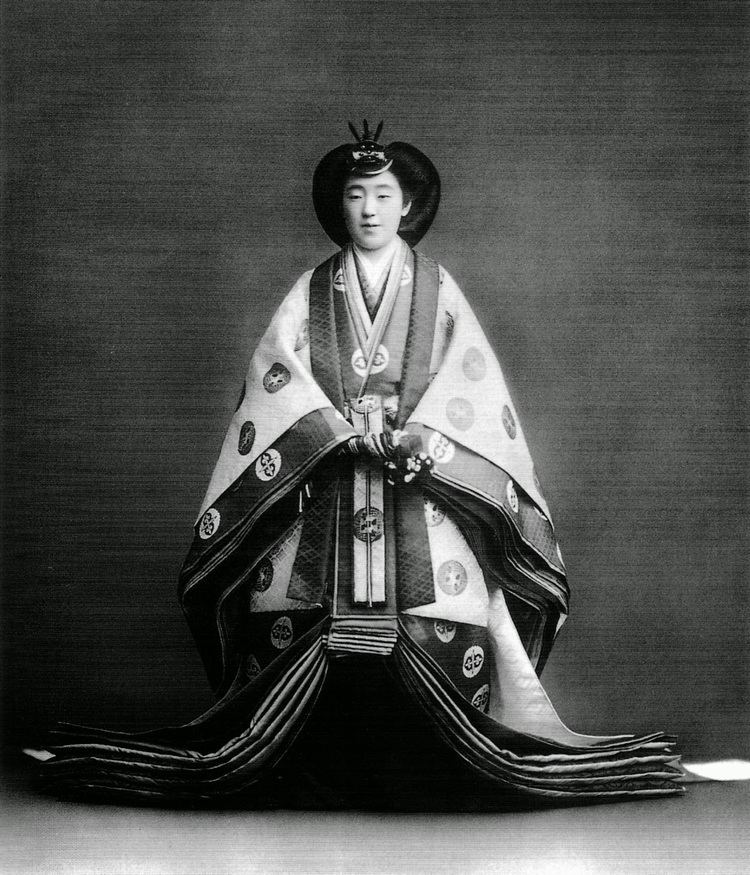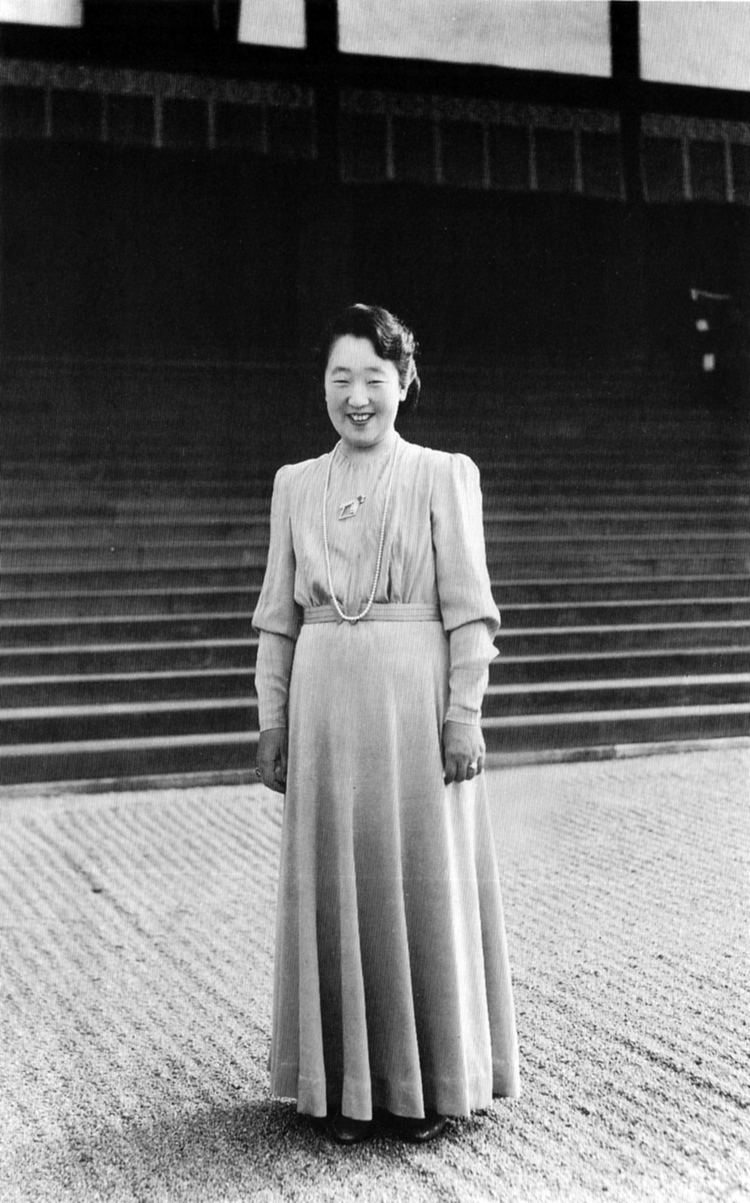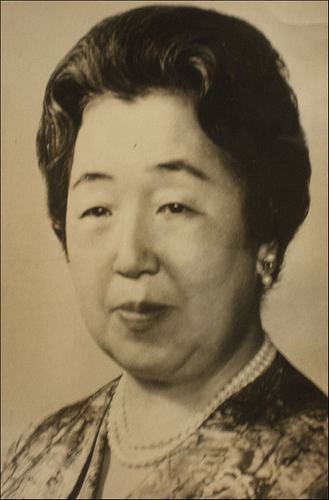Enthronement 10 November 1928 Mother Chikako Shimazui Role Consort Parents Prince Kuni Kuniyoshi | Father Prince Kuniyoshi Kuni Name Empress Kojun Spouse Hirohito (m. 1924–1989) House Imperial House of Japan | |
 | ||
Tenure 25 December 1926 –
7 January 1989 Born 6 March 1903
Tokyo, Japan ( 1903-03-06 ) Burial 25 July 2000
Musashi Imperial Graveyard, Hachioji, Tokyo, Japan Issue Shigeko, Princess Teru
Sachiko, Princess Hisa
Kazuko, Princess Taka
Atsuko, Princess Yori
Akihito, Emperor of Japan
Masahito, Prince Hitachi
Takako, Princess Suga Died June 16, 2000, Omiya Palace, Kyoto, Kyoto Prefecture, Japan Children Akihito, Masahito, Prince Hitachi, Shigeko Higashikuni Similar People Hirohito, Empress Michiko, Akihito, Empress Teimei, Naruhito | ||
Japanese Emperor Hirohito and Empress Kojun depart the Yasukuni Shrine in Tokyo a...HD Stock Footage
Empress Kōjun (香淳皇后, Kōjun-kōgō), born Princess Nagako (良子女王, Nagako Joō, 6 March 1903 – 16 June 2000), was the wife of Emperor Shōwa of Japan. She was the mother of the present emperor, Akihito.
Contents
- Japanese Emperor Hirohito and Empress Kojun depart the Yasukuni Shrine in Tokyo aHD Stock Footage
- Early life
- Marriage and children
- Life as empress
- Titles and styles
- National honours
- Foreign honours
- References

Her posthumous name is Kōjun, which means "fragrant purity". Empress Kōjun was empress consort (kōgō) from 25 December 1926 to 7 January 1989, making her the longest lived empress consort in Japanese history.

Early life

Princess Nagako was born in Tokyo, Japan, into one of the Ōke branches of the Imperial House of Japan, which are eligible to provide an heir to the throne of Japan (by adoption). She was therefore a Princess by birth, as the daughter of Kuniyoshi, Prince Kuni (1873–1929) by his consort, Chikako (1879–1956). While her father was a scion of the Imperial family itself, her mother descended from daimyōs, the feudal or military aristocracy. Nagako would become one of the last Japanese who could remember what life was like inside the Japanese aristocracy in the years before the Second World War.

As a young girl, Nagako attended the Girls' Department of Peers' School in Tokyo (now Gakushūin), which was a school set up especially for the daughters of the aristocracy and imperial family. Among her cohort was Crown Princess Bangja of Korea (then known as Princess Masako Nashimoto). Following her betrothal at age fourteen, Nagako was withdrawn from this school and began a six-year training program aimed at developing the accomplishments deemed necessary for an empress.
Marriage and children

Nagako was betrothed to her fourteenth cousin thrice removed (through Prince Fushimi Sadafusa's patrilineal descent), Prince Hirohito (1901–1989), at a very young age, in a match arranged by their parents, in the manner which was usual in Japanese society at that time. Her lineage and her father's unblemished military career were the major considerations. In January 1919, the engagement of Princess Nagako to her distant cousin, the then-Crown Prince Hirohito (later Emperor Shōwa), was announced. In a step away from tradition, Hirohito was allowed to choose his own bride. Nagako herself had no choice in the matter. At the age of 14, she and other eligible women participated in a tea ceremony at the Imperial Palace while the Crown Prince watched unseen from behind a screen. He eventually selected Nagako.

Princess Nagako married Crown Prince Hirohito on 26 January 1924 and became the Crown Princess of Japan. She became Empress upon Hirohito's accession to the throne on 25 December 1926. Unlike his royal predecessors, Emperor Hirohito decided to abandon his 39 court concubines. Over the first decade of marriage, Nagako produced only four daughters. It was only on December 23, 1933, almost ten years after their wedding, that the young couple had a son, and gave Japan an heir, in the birth of Akihito (明仁), the present emperor. In all, Hirohito and Nagako had seven children, five daughters and two sons. (see Issue)
Life as empress

Empress Nagako performed her ceremonial duties in a traditional manner. She initially came to live in the palace during the time when people spoke an archaic imperial form of Japanese that has largely disappeared. Her role required her to attend special ceremonies such as those for the 2600th anniversary of the legendary foundation of the Empire of Japan in 1940 or the conquest of Singapore in 1942.

The Empress was the first Japanese Imperial Consort to travel abroad. She accompanied Emperor Hirohito on his European tour in 1971 and later on his state visit to the United States in 1975. She became known as the "smiling Empress".

After the Emperor's death on 7 January 1989, she assumed the title of Empress Dowager. At that time, she was in failing health herself and did not attend her husband's funeral; and she remained in seclusion for the rest of her life. In 1995, she became the longest-living dowager empress of Japan, breaking the record of Empress Kanshi, who died 868 years earlier.
At the time of her death at the age of 97 in 2000, Nagako had been an empress for 74 years. In her final days, the Imperial Household Agency announced that she was suffering from breathing problems but that the illness was not serious. Nagako died at 4:46pm on 16 June 2000, with her family at her side.
Emperor Akihito granted his mother the posthumous title of Empress Kōjun. Her final resting place is in a mausoleum named Musashino no Higashi no Misasagi, near that of her husband within the Musashi Imperial Graveyard.
Titles and styles
Across the arc of her life and death, Empress Kōjun has been known by number of related, but distinct titles:
